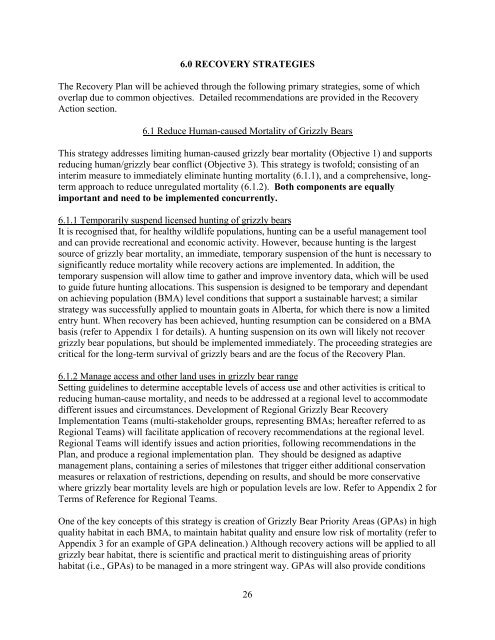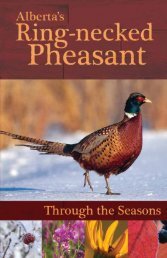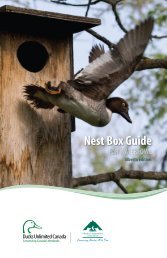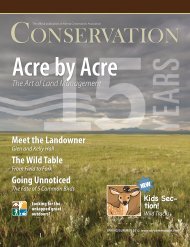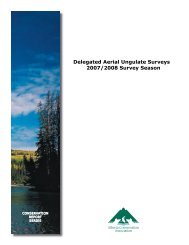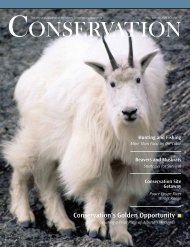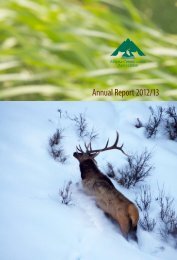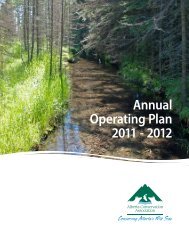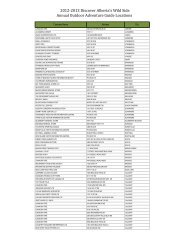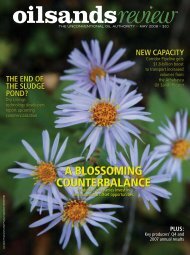Alberta Grizzly Bear Recovery Plan 2008-2013 - Alberta Sustainable ...
Alberta Grizzly Bear Recovery Plan 2008-2013 - Alberta Sustainable ...
Alberta Grizzly Bear Recovery Plan 2008-2013 - Alberta Sustainable ...
Create successful ePaper yourself
Turn your PDF publications into a flip-book with our unique Google optimized e-Paper software.
6.0 RECOVERY STRATEGIES<br />
The <strong>Recovery</strong> <strong>Plan</strong> will be achieved through the following primary strategies, some of which<br />
overlap due to common objectives. Detailed recommendations are provided in the <strong>Recovery</strong><br />
Action section.<br />
6.1 Reduce Human-caused Mortality of <strong>Grizzly</strong> <strong>Bear</strong>s<br />
This strategy addresses limiting human-caused grizzly bear mortality (Objective 1) and supports<br />
reducing human/grizzly bear conflict (Objective 3). This strategy is twofold; consisting of an<br />
interim measure to immediately eliminate hunting mortality (6.1.1), and a comprehensive, longterm<br />
approach to reduce unregulated mortality (6.1.2). Both components are equally<br />
important and need to be implemented concurrently.<br />
6.1.1 Temporarily suspend licensed hunting of grizzly bears<br />
It is recognised that, for healthy wildlife populations, hunting can be a useful management tool<br />
and can provide recreational and economic activity. However, because hunting is the largest<br />
source of grizzly bear mortality, an immediate, temporary suspension of the hunt is necessary to<br />
significantly reduce mortality while recovery actions are implemented. In addition, the<br />
temporary suspension will allow time to gather and improve inventory data, which will be used<br />
to guide future hunting allocations. This suspension is designed to be temporary and dependant<br />
on achieving population (BMA) level conditions that support a sustainable harvest; a similar<br />
strategy was successfully applied to mountain goats in <strong>Alberta</strong>, for which there is now a limited<br />
entry hunt. When recovery has been achieved, hunting resumption can be considered on a BMA<br />
basis (refer to Appendix 1 for details). A hunting suspension on its own will likely not recover<br />
grizzly bear populations, but should be implemented immediately. The proceeding strategies are<br />
critical for the long-term survival of grizzly bears and are the focus of the <strong>Recovery</strong> <strong>Plan</strong>.<br />
6.1.2 Manage access and other land uses in grizzly bear range<br />
Setting guidelines to determine acceptable levels of access use and other activities is critical to<br />
reducing human-cause mortality, and needs to be addressed at a regional level to accommodate<br />
different issues and circumstances. Development of Regional <strong>Grizzly</strong> <strong>Bear</strong> <strong>Recovery</strong><br />
Implementation Teams (multi-stakeholder groups, representing BMAs; hereafter referred to as<br />
Regional Teams) will facilitate application of recovery recommendations at the regional level.<br />
Regional Teams will identify issues and action priorities, following recommendations in the<br />
<strong>Plan</strong>, and produce a regional implementation plan. They should be designed as adaptive<br />
management plans, containing a series of milestones that trigger either additional conservation<br />
measures or relaxation of restrictions, depending on results, and should be more conservative<br />
where grizzly bear mortality levels are high or population levels are low. Refer to Appendix 2 for<br />
Terms of Reference for Regional Teams.<br />
One of the key concepts of this strategy is creation of <strong>Grizzly</strong> <strong>Bear</strong> Priority Areas (GPAs) in high<br />
quality habitat in each BMA, to maintain habitat quality and ensure low risk of mortality (refer to<br />
Appendix 3 for an example of GPA delineation.) Although recovery actions will be applied to all<br />
grizzly bear habitat, there is scientific and practical merit to distinguishing areas of priority<br />
habitat (i.e., GPAs) to be managed in a more stringent way. GPAs will also provide conditions<br />
26


